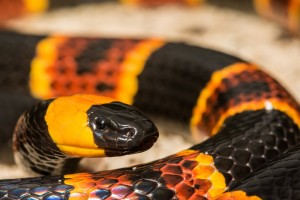 Burmese pythons get a lot of attention for living in the Everglades, even though they are an invasive species. However, there are 23 snake species in the Everglades and four are venomous. Snakes, although terrifying to many, help keep the ecosystem in balance. These snakes control the number of other snakes, invertebrates and rodents in the Park. Bird and alligators also prey on snakes.
Burmese pythons get a lot of attention for living in the Everglades, even though they are an invasive species. However, there are 23 snake species in the Everglades and four are venomous. Snakes, although terrifying to many, help keep the ecosystem in balance. These snakes control the number of other snakes, invertebrates and rodents in the Park. Bird and alligators also prey on snakes.
For this article, we wanted to detail the four venomous snakes that live in the Everglades, which include the Eastern coral snake, the Florida cottonmouth, the dusky pigmy rattlesnake, and the eastern diamondback rattlesnake.
Eastern Coral Snake – This snake has red, yellow, and black bands running down its body. It can usually be found in a wooded habitat and it is very elusive in nature, since it spends a lot of time under ground or beneath foliage. Coral snakes are not confrontational; they account for less than one percent of all bites that occur in North America each year; however, their bite is the most venomous of all the snakes on the continent. This snake’s bite isn’t overly painful, but can cause death within just a few hours.
Florida Cottonmouth – This snake is known as the “water moccasin.” It is a type of pit viper and it is the only semiaquatic viper species in the world. This snake can be found around shallow waters such as streams and marshes. These snakes can really swim. They are black, brown, tan or olive in color; the Florida cottonmouth also has a very thick body and can be up to six feet long. Its bite is painful and can lead to death.
Dusky Pigmy Rattlesnake—The dusky pigmy rattlesnake is a small snake between two to three feet. It can be found in both wet and dry areas. It is gray with black/brown dorsal spots across its back with white flecks on the stomach. This snake is aggressive and can be quick to bite with no warning. It has small fangs, so it only releases a small amount of venom with a bite. Its bite is rarely fatal, but can be more dangerous to a child or pet.
Eastern Diamondback Rattlesnake – This snake is the biggest of the venomous snakes in both mass and length; it can grow up to eight feet. This snake is also a great swimmer. It can be found by water or understand. The diamondback rattlesnake has dark diamonds across its body, each separated by a whiteish color. It is extremely venomous, but it is not aggressive. They rattling their tails to warn anyone who may be a
These poisonous snakes can look similar to many non-venomous snakes. So, how can you tell the difference between a venomous snake and a non-venomous snake?
- Most snakes with a triangular head are venomous.
- Snakes with lengthwise stripes are non-venomous.
Never approach or touch a snake if you’re unsure what kind of snake you are approaching. Even if you know your snakes, it’s better to leave wildlife alone. If you want snakes to stay away from you, it’s a good idea to make a lot of noise while walking, so the snakes are aware you’re around. Keep your hands out of potential snake hiding spots (logs, brush, leaves, rock piles), as well. Stick to the trails, because you’re less likely to run into a snake on a cleared path.
An airboat tour is a great way to stay safe in the Everglades without running the risk of encountering a snake. You may even get to see one slither by on land or water.
To check out the beautiful ecosystem that the snakes contribute to, Captain Mitch’s Airboat Tours will give you a glimpse of the Everglades like no other. To book an airboat ride, call 800-368-0065 or visit our Private Everglades Airboat Tours page. We are open seven days a week 8:30 a.m. to 5 p.m. If paying by cash, adults cost $40 (plus tax) and children 12 and under cost $20 (plus tax. If paying by credit card, adults cost $45 (plus tax) and children cost $25 (plus tax).






